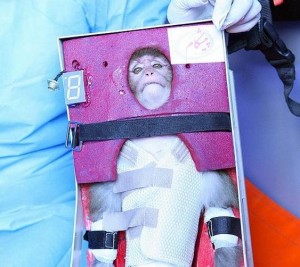 Iran said Saturday it has successfully sent a monkey into space for a second time, part of an ambitious program aimed at manned space flight.
Iran said Saturday it has successfully sent a monkey into space for a second time, part of an ambitious program aimed at manned space flight.Iran's state TV said that the launch of the rocket dubbed Pajohesh, or Research in Farsi, was Iran's first use of liquid fuel. It reached a height of 120 kilometres. It said the monkey, named Fargam or Auspicious, was returned to earth safely.
TV footage showed the rocket blasting off and then showed the monkey, strapped snugly into a seat. The report said Fargam's capsule parachuted safely to earth after detaching from the rocket in a mission that lasted 15 minutes.
Iran frequently claims technological breakthroughs that are impossible to independently verify. The Islamic Republic has said it aims to send an astronaut into space.
"The launch of Pajohesh is another long step getting the Islamic Republic of Iran closer to sending a man into space," the official IRNA news agency said.
Fargam is a male monkey of rhesus macaque race with brown fur and a pink face. The primate weighs three kilograms and has a height of 56 centimetres. Iranian scientists say a bigger monkey or another animal will be tested in the next space flight.
State TV said the rocket was equipped with new features including sonic sensors and electronic devices that enabled scientists to monitor the monkey, its vital signs and voice.
Mohammad Ebrahimi said Iran's first use of liquid fuel meant the rocket's speed was about half that of a rocket using solid fuel.
First monkey in January
Iran said it sent its first monkey into space in January, reaching the same height of 120 kilometres.
'The capsule was equipped with a shock�absorber�to provide better protection for the monkey.'-�Mohammad�Ebrahimi�from Iran's aerospace program
"The rocket carrying the first monkey used solid fuel and had a high speed. But a liquid fuel rocket has a lower speed and is better for the safety and protection of the living creature because it causes less pressure," IRNA quoted him as saying. "The capsule was equipped with a shock absorber to provide better protection for the monkey."
Ebrahimi said the monkey's appetite showed it was in good health after the journey.
Iran aerospace program is a source of national pride. It's also one of the pillars of its aspirations to be seen as the technological hub for Islamic and developing countries.
The U.S. and its allies worry that technology from the space program could also be used to develop long-range missiles that could potentially be armed with nuclear warheads.
In the January mission, one of two official packages of photos of the simian space traveler depicted the wrong monkey, causing some international observers to wonder whether the monkey had died in space or that the launch didn't go well.
But Iranian officials later said one set of pictures showed an archive photo of one of the alternate monkeys. They said three to five monkeys are simultaneously tested for such a flight and two or three are chosen for the launch. Finally, the one that is best suited for the mission is chosen for the voyage.
The Islamic Republic has not revealed where the rocket launch took place, but it has a major satellite launch complex near Semnan, about 200 kilometres�east of Tehran.
Iran says it wants to put its own satellites into orbit to monitor natural disasters in the earthquake-prone nation, improve telecommunications and expand military surveillance of the region.
By CBC News
The Iran Project is not responsible for the content of quoted articles.










